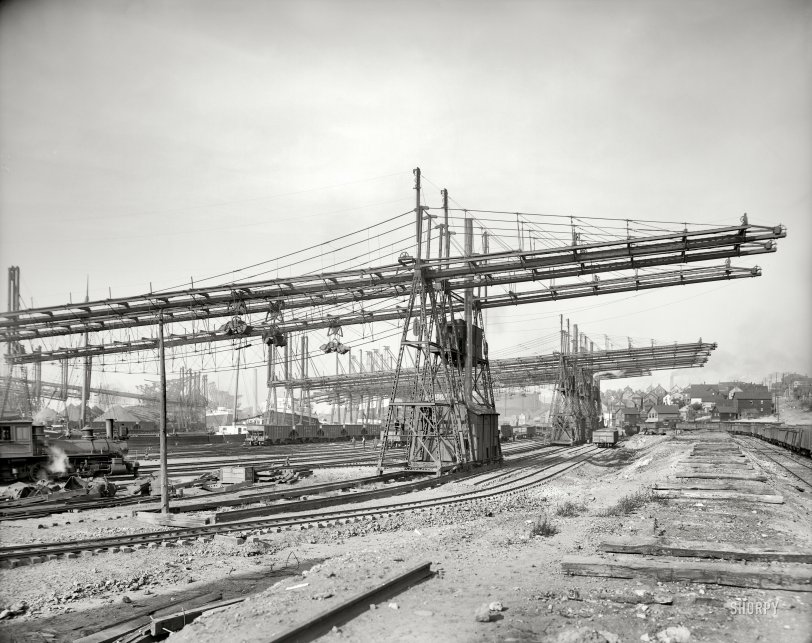


Framed or unframed, desk size to sofa size, printed by us in Arizona and Alabama since 2007. Explore now.
Shorpy is funded by you. Patreon contributors get an ad-free experience.
Learn more.

- Freeze Frame
- Texas Flyer wanted
- Just a Year Too Soon
- WWII -- Replacing men with women at the railroad crossing.
- Yes, Icing
- You kids drive me nuts!
- NOT An Easy Job
- I wonder
- Just add window boxes
- Icing Platform?
- Indiana Harbor Belt abides
- Freezing haze
- Corrections (for those who care)
- C&NW at Nelson
- Fallen Flags
- A dangerous job made worse
- Water Stop
- Passenger trains have right of way over freights?
- Coal
- Never ceases to amaze me.
- Still chuggin' (in model form)
- Great shot
- Westerly Breeze
- For the men, a trapeze
- Tickled
- Sense of loneliness ...
- 2 cents
- Charm City
- What an Outrage
- Brighton Park
Print Emporium
Heavy Lifting: 1910

Cleveland, Ohio, circa 1910. "Brown hoist machines." 8x10 inch dry plate glass negative, Detroit Publishing Company. View full size.
Conversion.
Looking at the locomotive on the left, I'm left to think that this is a conversion from a tank locomotive or camelback. The low slung boiler and high steam dome (as well as its position) suggest such a conversion, though I'm not sure which type.
Bridge Tramway Plant
"Brownhoist," Brown Hoisting Machinery Company, 1905.Bridge Tramway Plants
A Bridge Tramway plant generally consists of three or four "Standard Bridges," mounted side by side on suitable rails, each machine operating one hatch of a vessel. Two of these bridges are supported at their back ends on a double back pier; the other bridge or bridges are supported singly on single back piers.
BRIDGE. The bridge-girders are built of steel and iron, of our patent construction, designed to give the maximum strength with the minimum weight of material, with all the members made of such shapes and so arranged in the trusses as to offer the least possible surface to wind-pressure. Owing to the exposed locations where these machines are generally used, the question of wind-pressure becomes of the greatest importance.
…
FRONT PIERS. Each bridge is supported in front by an independent single pier of "A-frame" construction, built of steel mounted on wheels, and running on a single line of rails; each bridge is connected to the front pier (and back pier) in such a manner as to permit the front end of the bridge to be "skewed" or moved sidewise, to suit the hatches of a vessel without moving the rear end. This front pier is generally arranged to be moved by handpower by means of cranks geared to the track-wheels; but this is also done by power when desired.BACK PIERS. The back piers are built of steel and are mounted on wheels, and move on a track consisting of two lines of rails of suitable gauge, laid on the surface of wharf parallel to front of same. The back piers can be moved independently of the front piers by either hand or power. The double pier, containing the engine-house, is always moved by its own power.
HINGED APRON OVER VESSEL. Each machine is provided at its front end with a hinged apron of suitable length for extending the trolley tracks of the machine over the hatch of a vessel. This apron is hinged so that it can be raised in a vertical position when not in use, thereby keeping the front of the pier or dock entirely free and unobstructed, so that vessels with masts may come alongside. When the vessel is tied to the dock the aprons are lowered and adjusted to the hatches by moving the front piers. This hinged apron is generally raised by a hand-winch, but can be made to raise by power.
…
HOISTING- AND CONVEYING-MACHINE. This machine, also called the "trolley," runs along a track suspended from the bridge, between the girders, and from the farther end of the hinged apron, over the vessel, back to the rear end of the cantilever extension. This trolley, together with its suspended bottom block, hook, or grab-bucket, is attached to the hoisting- or pulling line, and its motions are under perfect control of the operator by means of suitable levers in the operator's house.
Monsters!
You have to love the Industrial Age, when machines were monsters and man was nothing more than their caretakers. It must have been a sight when all these machines were running. One really has to appreciate how things got done a hundred years ago.
























On Shorpy:
Today’s Top 5